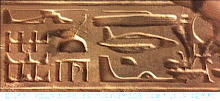
Hello readers,
Okay. Today we get a little bit deeper into the study of Physics and Astronomy by studying Chemistry, their complement. I had spoken earlier about atoms being star systems of previous universes... not metaphorically, but in actual fact. Of course you may have found loopholes, but I will attempt to fill those holes today, cool?
First of all, the Periodic table of elements has two sections. One section gives the atomic description of the 100 elements. These elements are those whose structure cannot be broken down further, they are not man-made. They are here because they ARE, like hydrogen, for example.
The second section gives us the atomic description of various compounds forged from these elements. But they are "compounds," hence, they can be broken down further.
Now remember, atoms are star systems, and electrons are planets. In the universe, there are 100 types of star systems.. and there are 100 types of elements. The star systems are organized by how many planets orbit the star. So, a type 1 star system has 1 planet which orbits it. A type 2 star system is orbited by two planets, so on and so forth up to Type 100.
Toward the end of a Universe, these star systems cluster together according to one of the seven cosmological laws: The Law of Attraction/The Law of Magnetic Attraction. This law states that type 1 star systems be attracted to type 1 star systems, and 2 and 2, and on and on.
Remember when I said that all the star systems, at the end of the universe, become the atoms forming the new earth? Well, the Type 1's come together and form, on the new earth, the gas referred to as Hydrogen. Very light, very unstable, as there are not many electrons (planets) to keep it from mixing/reacting with other elements. In the same way, all type 2's come together and form Helium. Also very light, and so it floats above the ground, just as hydrogen and form water and our atmosphere. Some of the elements are heavier, such as the metals like Gold, which sink into the new earth as opposed to float.

So, before I continue on to the second post here about the Second Law of Magnetic Attraction, we should review. Star systems (star and planets/nucleus and electron) cluster together at the end of a universe in order to form those atoms and compounds which constitute the new planet of the new Creation. These atoms are what form the elements of our Periodic Table. (It is very intricate and also involves the roles of Melanin and Carbon (The Black substance, "Kam"
which is the base of "Kem"istry) and their role in the formation of new stars and star systems, but this cannot all be tackled in a single post. You would be reading for weeks.











!["SO[U]L/ Shamush"](http://1.bp.blogspot.com/_D12CqvmBvdo/SXzEh7DvYuI/AAAAAAAAABA/oXOJnFas9Kk/S220/SO(U)L.jpg)





HI, I would like to know what book should I read to get more information on this topic.
ReplyDelete